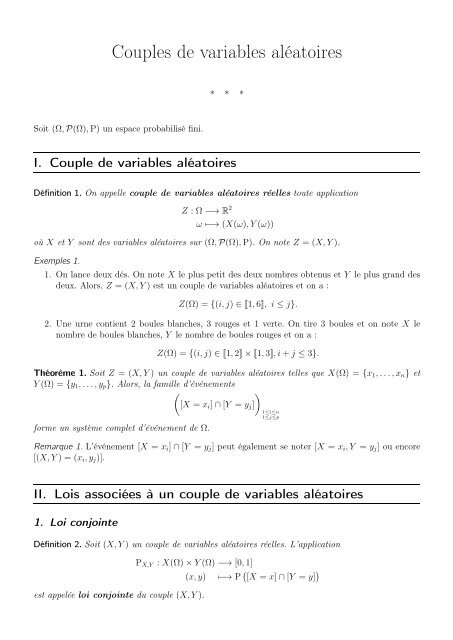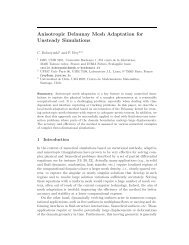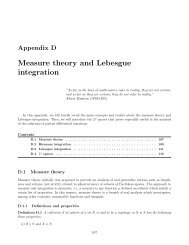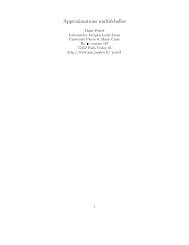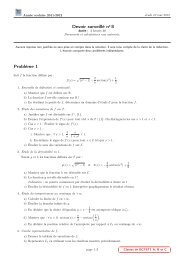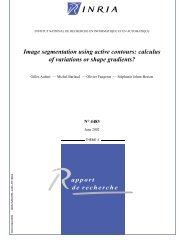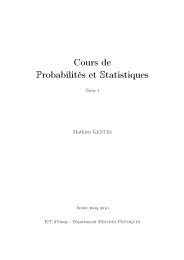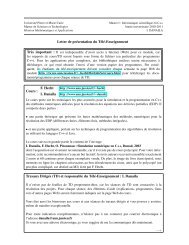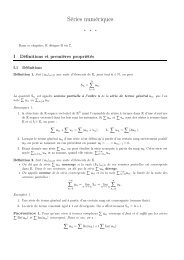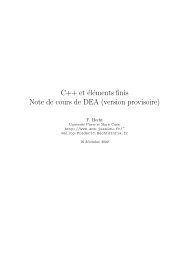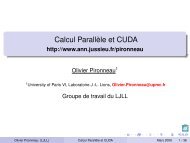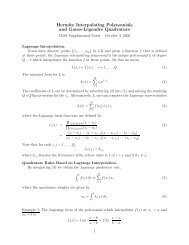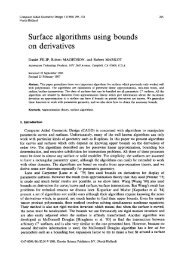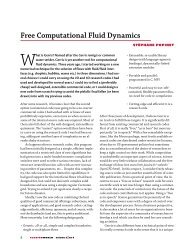Couples de variables aléatoires
Couples de variables aléatoires
Couples de variables aléatoires
Create successful ePaper yourself
Turn your PDF publications into a flip-book with our unique Google optimized e-Paper software.
<strong>Couples</strong> <strong>de</strong> <strong>variables</strong> <strong>aléatoires</strong><br />
Soit (Ω, P(Ω), P) un espace probabilisé fini.<br />
∗ ∗ ∗<br />
I. Couple <strong>de</strong> <strong>variables</strong> <strong>aléatoires</strong><br />
Définition 1. On appelle couple <strong>de</strong> <strong>variables</strong> <strong>aléatoires</strong> réelles toute application<br />
Z : Ω −→ R 2<br />
ω ↦−→ (X(ω), Y (ω))<br />
où X et Y sont <strong>de</strong>s <strong>variables</strong> <strong>aléatoires</strong> sur (Ω, P(Ω), P). On note Z = (X, Y ).<br />
Exemples 1.<br />
1. On lance <strong>de</strong>ux dés. On note X le plus petit <strong>de</strong>s <strong>de</strong>ux nombres obtenus et Y le plus grand <strong>de</strong>s<br />
<strong>de</strong>ux. Alors, Z = (X, Y ) est un couple <strong>de</strong> <strong>variables</strong> <strong>aléatoires</strong> et on a :<br />
Z(Ω) = {(i, j) ∈ [1, 6], i ≤ j}.<br />
2. Une urne contient 2 boules blanches, 3 rouges et 1 verte. On tire 3 boules et on note X le<br />
nombre <strong>de</strong> boules blanches, Y le nombre <strong>de</strong> boules rouges et on a :<br />
Z(Ω) = {(i, j) ∈ [1, 2] × [1, 3], i + j ≤ 3}.<br />
Théorème 1. Soit Z = (X, Y ) un couple <strong>de</strong> <strong>variables</strong> <strong>aléatoires</strong> telles que X(Ω) = {x1, . . . , xn} et<br />
Y (Ω) = {y1, . . . , yp}. Alors, la famille d’événements<br />
<br />
<br />
[X = xi] ∩ [Y = yj]<br />
1≤i≤n<br />
1≤j≤p<br />
forme un système complet d’événement <strong>de</strong> Ω.<br />
Remarque 1. L’événement [X = xi] ∩ [Y = yj] peut également se noter [X = xi, Y = yj] ou encore<br />
[(X, Y ) = (xi, yj)].<br />
II. Lois associées à un couple <strong>de</strong> <strong>variables</strong> <strong>aléatoires</strong><br />
1. Loi conjointe<br />
Définition 2. Soit (X, Y ) un couple <strong>de</strong> <strong>variables</strong> <strong>aléatoires</strong> réelles. L’application<br />
est appelée loi conjointe du couple (X, Y ).<br />
PX,Y : X(Ω) × Y (Ω) −→ [0, 1]<br />
(x, y) ↦−→ P [X = x] ∩ [Y = y]
2 Lycée CHATEAUBRIAND - BCPST 1B<br />
Remarque 2. La loi conjointe d’un couple <strong>de</strong> <strong>variables</strong> <strong>aléatoires</strong> est souvent représentée sous forme<br />
<strong>de</strong> tableau. Si X(Ω) = {x1, . . . , xn} et Y (Ω) = {y1, . . . , yp}, on note<br />
Exemple 2.<br />
pi,j = P [X = xi] ∩ [Y = yj] .<br />
Proposition 1. Soit (X, Y ) un couple <strong>de</strong> <strong>variables</strong> <strong>aléatoires</strong> tel que X(Ω) = {x1, . . . , xn} et Y (Ω) =<br />
{y1, . . . , yp}. Alors,<br />
n<br />
i=1<br />
p<br />
P [X = xi] ∩ [Y = yj] =<br />
j=1<br />
p<br />
j=1<br />
n<br />
P [X = xi] ∩ [Y = yj] = 1.<br />
Remarque 3. La somme <strong>de</strong>s coefficients du tableau qui représente la loi conjointe vaut 1 :<br />
<br />
1≤i≤n<br />
1≤j≤p<br />
i=1<br />
pi,j = 1.<br />
Les <strong>de</strong>ux formules <strong>de</strong> la proposition précé<strong>de</strong>nte correspon<strong>de</strong>nt respectivement aux sommes <strong>de</strong>s coefficients<br />
obtenus sur chaque ligne ou sur chaque colonne.<br />
2. Lois marginales<br />
Définition 3. Soit (X, Y ) un couple <strong>de</strong> <strong>variables</strong> <strong>aléatoires</strong>. On appelle lois marginales les lois <strong>de</strong><br />
probabilités <strong>de</strong>s <strong>variables</strong> <strong>aléatoires</strong> X et Y .<br />
Théorème 2. Soit (X, Y ) un couple <strong>de</strong> <strong>variables</strong> <strong>aléatoires</strong> tel que X(Ω) = {x1, . . . , xn} et Y (Ω) =<br />
{y1, . . . , yp}. Alors, on peut retrouver les lois <strong>de</strong> X et Y à partir <strong>de</strong> la loi conjointe :<br />
∀ i ∈ [1, n], P(X = xi) =<br />
∀ j ∈ [1, p], P(Y = yj) =<br />
p<br />
P [X = xi] ∩ [Y = yj] ,<br />
j=1<br />
n<br />
P [X = xi] ∩ [Y = yj] .<br />
Remarque 4. En utilisant la représentation <strong>de</strong> la loi conjointe à l’ai<strong>de</strong> d’un tableau, il suffit <strong>de</strong> faire<br />
la somme <strong>de</strong>s lignes pour obtenir la loi X et la somme <strong>de</strong>s colonnes pour obtenir la loi <strong>de</strong> Y .<br />
Exemple 3.<br />
3. Lois conditionnelles<br />
Définition 4. Soit (X, Y ) un couple <strong>de</strong> <strong>variables</strong> <strong>aléatoires</strong>.<br />
∗ Pour tout y ∈ Y (Ω) tel que P([Y = y]) = 0, l’application<br />
P[Y =y] : X(Ω) −→ [0, 1]<br />
i=1<br />
x ↦−→ P [X = x] ∩ [Y = y] <br />
P([Y = y])<br />
est appelée loi conditionnelle <strong>de</strong> X sachant [Y = y].<br />
= P([X = x] [Y = y])
Chapitre 24 - <strong>Couples</strong> <strong>de</strong> var 3<br />
∗ Pour tout x ∈ X(Ω) tel que P([X = x]) = 0, l’application<br />
P[X=x] : Y (Ω) −→ [0, 1]<br />
y ↦−→ P [X = x] ∩ [Y = y] <br />
P([X = x])<br />
est appelée loi conditionnelle <strong>de</strong> Y sachant [X = x].<br />
= P([Y = y] [X = x])<br />
Exemple 4. Retour à l’exemple <strong>de</strong> l’urne contenant 2 boules blanches, 3 rouges et 1 verte.<br />
On reconnaît <strong>de</strong>s lois hypergéométriques.<br />
Proposition 2. Soit (X, Y ) un couple <strong>de</strong> <strong>variables</strong> <strong>aléatoires</strong> tel que X(Ω) = {x1, . . . , xn} et Y (Ω) =<br />
{y1, . . . , yp}. Alors, on peut retrouver les lois <strong>de</strong> X et Y à partir <strong>de</strong>s lois conditionnelles :<br />
4. Indépendance<br />
∀ i ∈ [1, n], P(X = xi) =<br />
∀ j ∈ [1, p], P(Y = yj) =<br />
p<br />
j=1<br />
n<br />
i=1<br />
P [Y = yj] <br />
P[Y =yj] [X = xi] ,<br />
P [X = xi] <br />
P[X=xi] [Y = yj] .<br />
Définition 5. Deux <strong>variables</strong> <strong>aléatoires</strong> réelles X et Y sont dites indépendantes si<br />
∀ (x, y) ∈ X(Ω) × Y (Ω), P [X = x] ∩ [Y = y] = P(X = x) P(Y = y),<br />
cela signifie que pour tout couple (x, y) ∈ X(Ω) × Y (Ω), les événements [X = x] et [Y = y] sont<br />
indépendants.<br />
Remarques 5. Si X et Y sont <strong>de</strong>s <strong>variables</strong> <strong>aléatoires</strong> indépendantes :<br />
1. La loi du couple s’obtient directement à partir <strong>de</strong>s lois marginales.<br />
2. Pour tout y ∈ Y (Ω) tel que P([Y = y]) = 0, la loi conditionnelle <strong>de</strong> X sachant [Y = y] est<br />
égale à la loi <strong>de</strong> X :<br />
<br />
∀ (x, y) ∈ X(Ω) × Y (Ω), P[Y =y] [X = x] = P [X = x] .<br />
3. Pour tout x ∈ X(Ω) tel que P([X = x]) = 0, la loi conditionnelle <strong>de</strong> Y sachant [X = x] est<br />
égale à la loi <strong>de</strong> Y :<br />
<br />
∀ (x, y) ∈ X(Ω) × Y (Ω), P[X=x] [Y = y] = P [Y = y] .<br />
Exemple 5. Une urne contient n jetons numérotés <strong>de</strong> 1 à n. On en tire <strong>de</strong>ux avec remise et on note<br />
X et Y les numéros <strong>de</strong>s jetons obtenus respectivement au premier et second tirages. Les <strong>variables</strong><br />
<strong>aléatoires</strong> X et Y sont indépendantes.<br />
Si le tirage est effectué sans remise, les <strong>variables</strong> <strong>aléatoires</strong> X et Y ne sont plus indépendantes.<br />
Proposition 3. Soient X et Y <strong>de</strong>ux <strong>variables</strong> <strong>aléatoires</strong> indépendantes. Alors pour toute parties A ⊂<br />
X(Ω) et B ⊂ Y (Ω), les événements [X ∈ A] et [Y ∈ B] sont indépendants.<br />
Exemple 6. Dans le cas <strong>de</strong> l’urne où les tirages sont effectués avec remise :<br />
1. les événements [X ∈ {2, 4, 6}] et [Y = 2] sont indépendants,<br />
2. les événements [X = 3] et [2 ≤ Y ≤ 5] sont indépendants.
4 Lycée CHATEAUBRIAND - BCPST 1B<br />
III. Variable aléatoire fonction <strong>de</strong> <strong>de</strong>ux <strong>variables</strong> <strong>aléatoires</strong><br />
1. Loi d’une variable aléatoire fonction <strong>de</strong> <strong>de</strong>ux <strong>variables</strong> <strong>aléatoires</strong><br />
Définition 6. Soient (X, Y ) un couple <strong>de</strong> <strong>variables</strong> <strong>aléatoires</strong> et u : R 2 −→ R une application. On<br />
définit la variable notée u(X, Y ) par :<br />
u(X, Y ) : Ω −→ R<br />
ω ↦−→ u X(ω), Y (ω) .<br />
Proposition 4. La loi <strong>de</strong> Z = u(X, Y ) est donnée par par :<br />
∀ z ∈ Z(Ω), P(Z = z) = <br />
P [X = x] ∩ [Y = y] .<br />
(x,y) | u(x,y)=z<br />
2. Cas particulier <strong>de</strong> la somme <strong>de</strong> <strong>de</strong>ux <strong>variables</strong> <strong>aléatoires</strong><br />
Proposition 5. Soient (X, Y ) un couple <strong>de</strong> <strong>variables</strong> <strong>aléatoires</strong>. La loi <strong>de</strong> Z = X + Y est donnée par<br />
par :<br />
∀ z ∈ Z(Ω), P(Z = z) = <br />
P [X = x] ∩ [Y = y] .<br />
(x,y) | x+y=z<br />
Exercice 1. On effectue <strong>de</strong>ux tirages successifs et sans remise dans une urne contenant 4 boules<br />
numérotées <strong>de</strong> 1 à 4. On note X le plus petit <strong>de</strong>s numéros tirés et Y le plus grand.<br />
En utilisant la loi conjointe du couples (X, Y ), déterminer la loi <strong>de</strong> Z = X + Y .<br />
Théorème 3. Soient X ↩→ B(m, p) et Y ↩→ B(n, p) <strong>de</strong>ux <strong>variables</strong> <strong>aléatoires</strong> indépendantes.<br />
Alors,<br />
X + Y ↩→ B(m + n, p).<br />
3. Espérance d’une variable aléatoire fonction <strong>de</strong> <strong>de</strong>ux <strong>variables</strong> <strong>aléatoires</strong><br />
Théorème 4 (Theorem <strong>de</strong> transfert). Soient (X, Y ) un couple <strong>de</strong> <strong>variables</strong> <strong>aléatoires</strong> réelles sur<br />
(Ω, P(Ω), P) telles que X(Ω) = {x1, . . . , xn} et Y (Ω) = {y1, . . . , yp} et u : R 2 −→ R une application.<br />
Alors,<br />
E(u(X, Y )) = <br />
1≤i≤n<br />
1≤j≤p<br />
u(xi, yj) P [X = xi] ∩ [Y = yj] =<br />
n<br />
i=1<br />
p<br />
u(xi, yj)pi,j =<br />
Exemple 7. Retour à l’exercice précé<strong>de</strong>nt. On recherche <strong>de</strong> l’espérance <strong>de</strong> Z = XY .<br />
Proposition 6. Soient X, Y <strong>de</strong>s <strong>variables</strong> <strong>aléatoires</strong> réelles et a, b <strong>de</strong>s réels. Alors,<br />
On dit que l’espérance est linéaire.<br />
j=1<br />
E(aX + bY ) = aE(X) + bE(Y ).<br />
p<br />
j=1<br />
n<br />
i=1<br />
u(xi, yj)pi,j.
Chapitre 24 - <strong>Couples</strong> <strong>de</strong> var 5<br />
IV. Covariance - coefficient <strong>de</strong> corrélation linéaire<br />
1. La covariance<br />
Définition 7. Soient X et Y <strong>de</strong>ux <strong>variables</strong> <strong>aléatoires</strong> réelles. On appelle covariance <strong>de</strong> X et Y le<br />
réel défini par :<br />
Cov(X, Y ) = E (X − E(X))(Y − E(Y )) .<br />
Théorème 5 (Kœnig-Huygens). Soient X et Y <strong>de</strong>ux <strong>variables</strong> <strong>aléatoires</strong> réelles. Alors, on a :<br />
Cov(X, Y ) = E(XY ) − E(X)E(Y ).<br />
Propriétés 1. Soient X, X ′ , Y, Y ′ <strong>de</strong>s <strong>variables</strong> <strong>aléatoires</strong> réelles et a, b <strong>de</strong>s réels. Alors, on a les<br />
propriétés suivantes :<br />
1. Cov(X, X) = V(X),<br />
2. Cov(Y, X) = Cov(X, Y ),<br />
3. Cov(aX + bX ′ , Y ) = a Cov(X, Y ) + b Cov(X ′ , Y ),<br />
4. Cov(X, aY + bY ′ ) = a Cov(X, Y ) + b Cov(X, Y ′ ).<br />
Exemple 8. Retour à l’exemple précé<strong>de</strong>nt.<br />
2. Le coefficient <strong>de</strong> corrélation linéaire<br />
Définition 8. Soient X et Y <strong>de</strong>ux <strong>variables</strong> <strong>aléatoires</strong> d’écart-types non nuls. On appelle coefficient<br />
<strong>de</strong> corrélation linéaire le réel :<br />
Cov(X, Y )<br />
ρ(X, Y ) =<br />
σ(X)σ(Y ) .<br />
Théorème 6. Soient X et Y <strong>de</strong>ux <strong>variables</strong> <strong>aléatoires</strong> d’écart-types non nuls. Alors, on a :<br />
1. ρ(X, Y ) ∈ [−1, 1],<br />
2. |ρ(X, Y )| = 1 ⇔ ∃ a, b ∈ R, Y = aX + b.<br />
Définition 9. On dit que <strong>de</strong>ux <strong>variables</strong> <strong>aléatoires</strong> X et Y sont non corrélées si<br />
lorsque ce <strong>de</strong>rnier est défini.<br />
Cov(X, Y ) = 0 ou encore ρ(X, Y ) = 0,<br />
3. Calcul <strong>de</strong> variance d’une somme <strong>de</strong> <strong>variables</strong> <strong>aléatoires</strong><br />
Théorème 7. Soit (X, Y ) un couple <strong>de</strong> <strong>variables</strong> <strong>aléatoires</strong>. Alors, on a :<br />
Plus généralement, pour tous réels a et b, on a :<br />
V(X + Y ) = V(X) + V(Y ) + 2Cov(X, Y ).<br />
V(aX + bY ) = a 2 V (X) + b 2 V (Y ) + 2Cov(X, Y ).
6 Lycée CHATEAUBRIAND - BCPST 1B<br />
4. Cas <strong>de</strong> <strong>variables</strong> <strong>aléatoires</strong> indépendantes<br />
Théorème 8. Soient X et Y <strong>de</strong>ux <strong>variables</strong> <strong>aléatoires</strong> réelles indépendantes. Alors,<br />
1. E(XY ) = E(X)E(Y ), en particulier Cov(X, Y ) = 0 et ρ(X, Y ) = 0,<br />
2. V(X + Y ) = V(X) + V(Y ).<br />
Remarque 6.<br />
1. Le premier résultat assure que <strong>de</strong>ux <strong>variables</strong> <strong>aléatoires</strong> indépendantes sont non corrélées.<br />
Attention La réciproque est fausse en général : si E(XY ) = E(X)E(Y ) n’implique pas X et<br />
Y indépendantes.<br />
2. Ce résultat permet néanmoins <strong>de</strong> montrer par contraposition que : si E(XY ) = E(X)E(Y ),<br />
alors Xet Y ne sont pas indépendantes.<br />
Exemple 9. Dans l’exemple précé<strong>de</strong>nt, on retrouve le fait que les <strong>variables</strong> X et Y ne sont pas<br />
indépendantes.<br />
Exercice 2. Soient X et Y <strong>de</strong>ux <strong>variables</strong> <strong>aléatoires</strong> <strong>de</strong> Bernoulli indépendantes et <strong>de</strong> même paramètre<br />
p ∈ ]0, 1[. Soient U = X + Y et V = X − Y .<br />
1. Déterminer la loi du couple (U, V ),<br />
2. Déterminer la covariance Cov(U, V ).<br />
3. Les <strong>variables</strong> <strong>aléatoires</strong> U et V sont-elles indépendantes ? Conclusion.<br />
V. Familles <strong>de</strong> n <strong>variables</strong> <strong>aléatoires</strong><br />
1. Définition<br />
Définition 10. On appelle vecteur <strong>de</strong> <strong>variables</strong> <strong>aléatoires</strong> réelles toute application<br />
Z : Ω −→ R n<br />
ω ↦−→ (X1(ω), X2(ω), . . . , Xn(ω))<br />
où X1, . . . , Xn sont <strong>de</strong>s <strong>variables</strong> <strong>aléatoires</strong> sur (Ω, P(Ω), P). On note Z = (X1, X2, . . . , Xn).<br />
Définition 11. Soit (X1, X2, . . . , Xn) un vecteur <strong>de</strong> <strong>variables</strong> <strong>aléatoires</strong> réelles. L’application<br />
P(X1,...,Xn) : X1(Ω) × · · · × Xn(Ω) −→ [0, 1]<br />
(x1, . . . , xn) ↦−→ P [X1 = x1] ∩ · · · ∩ [Xn = xn] <br />
est appelée loi conjointe du vecteur (X1, . . . , Xn).<br />
2. Indépendance mutuelle<br />
Définition 12. Les <strong>variables</strong> <strong>aléatoires</strong> réelles X1, . . . , Xn sont dites indépendantes ou mutuellement<br />
indépendantes si<br />
∀ (x1, . . . , xn) ∈ X1(Ω) × · · · × Xn(Ω), P [X1 = x1] ∩ · · · [Xn = xn] = P(X1 = x1) · · · P(Xn = xn).<br />
c’est-à-dire pour tous (x1, . . . , xn) ∈ X1(Ω) × · · · × Xn(Ω), les événements [X1 = x1], . . . , [Xn = xn]<br />
sont mutuellement indépendants.
Chapitre 24 - <strong>Couples</strong> <strong>de</strong> var 7<br />
Proposition 7. Soit (X1, . . . , Xn) une famille <strong>de</strong> <strong>variables</strong> <strong>aléatoires</strong> réelles mutuellement indépendantes.<br />
Alors, toute sous-famille l’est aussi.<br />
Exemple 10. Soient X, Y, Z, T <strong>de</strong>s <strong>variables</strong> <strong>aléatoires</strong> mutuellement indépendantes. Alors, X, Y, T<br />
sont mutuellement indépendantes.<br />
Théorème 9 (Lemme <strong>de</strong>s coalitions). Soit (X1, . . . , Xn, Xn+1, . . . , Xp) une famille <strong>de</strong> <strong>variables</strong> <strong>aléatoires</strong><br />
réelles mutuellement indépendantes.<br />
1. Soit f : R n −→ R et g : R p−n −→ R. Alors, les <strong>variables</strong> <strong>aléatoires</strong> f(X1, . . . , Xn) et<br />
g(Xn+1, . . . , Xp) sont indépendantes.<br />
2. Soit f1, . . . , fp <strong>de</strong>s fonctions <strong>de</strong> R dans R. Alors, les <strong>variables</strong> <strong>aléatoires</strong> f1(X1), . . . , fp(Xp)<br />
sont mutuellement indépendantes.<br />
Exemple 11. Soient X, Y, Z, T <strong>de</strong>s <strong>variables</strong> <strong>aléatoires</strong> mutuellement indépendantes. Alors,<br />
1. X 2 + Y et ZT sont indépendantes.<br />
2. X, 2Y + e Z et T 3 sont mutuellement indépendantes.<br />
3. Somme <strong>de</strong> <strong>variables</strong> <strong>aléatoires</strong><br />
Théorème 10. Soit X1, . . . , Xn une famille <strong>de</strong> <strong>variables</strong> <strong>aléatoires</strong> indépendantes suivant toutes une<br />
loi <strong>de</strong> Bernoulli <strong>de</strong> paramètre p. Alors,<br />
X1 + · · · + Xn ↩→ B(n, p).<br />
Proposition 8. Soit X1, . . . , Xn une famille <strong>de</strong> <strong>variables</strong> <strong>aléatoires</strong>. On a :<br />
n<br />
∗ E(X1 + · · · + Xn) = E(Xk),<br />
∗ V(X1 + · · · + Xn) =<br />
k=1<br />
n<br />
V(Xk) + 2 <br />
k=1<br />
1≤i≤j≤n<br />
Cov(Xi, Xj).<br />
En particulier, si les <strong>variables</strong> sont indépendantes, on a :<br />
V(X1 + · · · + Xn) =<br />
n<br />
V(Xk).<br />
k=1


